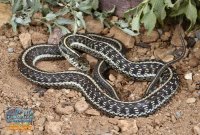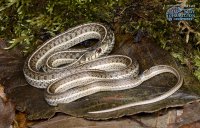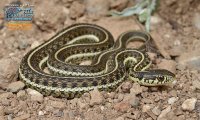| Range: |
 Limited to the SW corner of the state, they were thought to be extirpated from the state until a team from the ABQ Biopark found some in 2013. Limited to the SW corner of the state, they were thought to be extirpated from the state until a team from the ABQ Biopark found some in 2013. |
| Other Names: |
Brown Garter, Garden Snake, Gardener Snake, Grass Snake |
| Subspecies: |
Northern Mexican Garter Snake Thamnophis eques megalops |
| Description: |
Adults are 18" - 49". They may have paired blotches at the back of the
head running down back. There is a yellowish or cream middorsal
stripe that runs down the back. Dorsal scales are keeled. In parts of its
range it has obscure black body spots. |
| Similar Species: |
Patchnoses and whipsnakes have smooth scales, a divided anal plate and no spots. The Common Garter has relatively larger eyes, generally 7 upper labial scales, a wide, yellow, vertebral stripe, often has red coloring between the lateral scales and usually a plain bluish gray belly. The Checkered Garter has side stripe usually contained to 3rd scale row on front of body and more prominent paired dark blotches at back of head. The Black-necked Garter has well defined neck blotches and a yellow to orange vertebral stripe. The Plains Garter usually had 19 scale rows, seven upper labials and the lateral stripeon the 3rd and 4th scale rows. |
| Venom: |
Garters were long thought to be nonvenomous, but recent discoveries have revealed that they do in fact produce a mild neurotoxic venom. Garter snakes cannot kill humans with the small amounts of venom they produce, which is comparatively mild, and they also lack an effective means of delivering it. They do have enlarged teeth in the back of their mouth, but their gums are significantly larger. The Duvernoy's gland of garters are posterior (to the rear) of the snake's eyes. The mild venom is spread into wounds through a chewing action. - Wikipedia |
| Habitat: |
A highland canyon snake of pinon-juniper, pine oak forest, but also
enters mesquite grassland and desert, along valley stream courses.
Attracted to permanent water sources around vegetation. |
| Behavior: |
|
| Hibernation: |
|
| Reproduction: |
Live bearing, has 7-26 young. |
| Diet: |
Feeds on frogs, toads, tadpoles, fish, salamanders, lizards, small
mammals, earthworms, crustaceans and nestlings. |
Authored by: Garth Teitjen
Sources:



|















